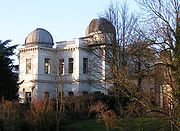
Frederik Kaiser
Encyclopedia

Netherlands
The Netherlands is a constituent country of the Kingdom of the Netherlands, located mainly in North-West Europe and with several islands in the Caribbean. Mainland Netherlands borders the North Sea to the north and west, Belgium to the south, and Germany to the east, and shares maritime borders...
astronomer
Astronomer
An astronomer is a scientist who studies celestial bodies such as planets, stars and galaxies.Historically, astronomy was more concerned with the classification and description of phenomena in the sky, while astrophysics attempted to explain these phenomena and the differences between them using...
.
He was director of the Leiden Observatory
Leiden Observatory
Leiden Observatory is an astronomical observatory in the city of Leiden, Netherlands. It was established by Leiden University in 1633, to house the quadrant of Snellius, and is the oldest operating University observatory in the world Leiden Observatory (Sterrewacht Leiden in Dutch) is an...
from 1838 until his death.
He is credited with the advancement of Dutch astronomy through his scientific contributions of positional measurements, his popularization of astronomy in the Netherlands
Netherlands
The Netherlands is a constituent country of the Kingdom of the Netherlands, located mainly in North-West Europe and with several islands in the Caribbean. Mainland Netherlands borders the North Sea to the north and west, Belgium to the south, and Germany to the east, and shares maritime borders...
, and by helping to build a state-of-the-art observatory
Observatory
An observatory is a location used for observing terrestrial or celestial events. Astronomy, climatology/meteorology, geology, oceanography and volcanology are examples of disciplines for which observatories have been constructed...
in 1861 (Today it is known as the "Old Observatory").

Mars
Mars is the fourth planet from the Sun in the Solar System. The planet is named after the Roman god of war, Mars. It is often described as the "Red Planet", as the iron oxide prevalent on its surface gives it a reddish appearance...
at its opposition in 1862 and made a fairly precise determination of its rotational period.
Craters
Impact crater
In the broadest sense, the term impact crater can be applied to any depression, natural or manmade, resulting from the high velocity impact of a projectile with a larger body...
on Mars and on the Moon
Kaiser (lunar crater)
Kaiser is a lunar crater. It lies in the crater-riddled terrain in the southern part of the Moon's near side. The crater is nearly attached to the northeast rim the slightly larger crater Fernelius, and the two are separated by an irregular patch of ground only a few kilometers wide...
are named in his honour, as well as asteroid
Asteroid
Asteroids are a class of small Solar System bodies in orbit around the Sun. They have also been called planetoids, especially the larger ones...
1694 Kaiser
1694 Kaiser
1694 Kaiser is a main-belt asteroid discovered on September 29, 1934 by H. van Gent at Johannesburg . It was named after the Dutch astronomer Frederik Kaiser.- External links :*...
.
In Richard Proctor's now-abandoned Martian nomenclature, Syrtis Major Planum was called the "Kaiser Sea". This nomenclature was later dropped in favor of the one introduced by Giovanni Schiaparelli
Giovanni Schiaparelli
Giovanni Virginio Schiaparelli was an Italian astronomer and science historian. He studied at the University of Turin and Berlin Observatory. In 1859-1860 he worked in Pulkovo Observatory and then worked for over forty years at Brera Observatory...
.
External links
- Obituary
- Petra van der Heijden Frederik Kaiser (1808-1872) and the modernisation of Dutch astronomy

